|
“Styles
win fights!” That is a pretty well know saying in combat sports. Simply put it means if you always attack an opponent
the same way every time one time or another that style is not going to work and you’re going to find yourself on the
short end of the stick. Varied approaches will always work best on varied opponents. The same method of thinking can be applied
when training muscle groups. One theory that bodybuilders have mastered is attacking muscle groups with a variety of exercises
and angles develops growth in many ways. Two people can use the same exercise for a muscle group but how they perform it can
have a profound difference on how their muscles develop. The squat is a perfect example of how sometimes a person can be doing
the right thing but not getting the results they want.. The squat is the best mass builder for legs period! The problem some
people run into though is with squatting sometimes their quads do not get enough work in comparison to their glutes and hamstrings.
Today we are going to look at what can be done so someone’s quads can get a good hammering next leg training session.
Two is usually better than one-
For most people, leg training consist of
doing some exercises that involve the legs. Most people go in to work the legs but do not individualize the parts. The problem
with this is when doing multi joint exercises “The strong will dominate!” This means if one particular muscle
group in the legs are stronger than another, it is going to end up doing most of the work. For a massive muscle group like
legs, I think they should be broken up into individual days. People break up their biceps and triceps into individual workouts
all of the time. It often amazes me how people are always willing to break their
posteriors down into workouts for the back, the rear delts, and the traps, but when it comes to some of the biggest muscles
in the body one workout for the entire leg region is sufficient. If you’re really serious about growing your legs, and
they are not growing now, try splitting them up into quad and hamstring workouts. Understand the muscles of the legs are some
of the biggest in our bodies and it will take a lot of work to develop them. By splitting your leg training up you can also
focus more on the individual body parts of the legs. By splitting things up you have more energy for each part and one part
does not become an afterthought after one long leg session. Another benefit is you can concentrate on the individual parts
more and not use a “one size fits all” approach.
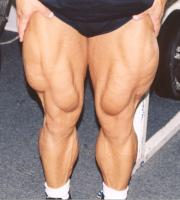
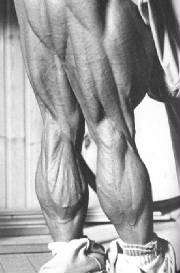
Examining what your doing-
Do you work your legs routinely but your
thighs have little to show for it? Do they lack that outer sweep look that
makes them look like they bulge out rather than go straight down? Do you have “Turnip Legs”? Are your butt and hamstrings doing all your leg work and you are not getting a lot out of your thighs? The
first thing you want to do is look at how you are training your legs. The first question I am going to ask is “Are you
training your legs?” If you answered no to that question first thing you want to do is stop reading this article and
start actually doing legs. If in a few weeks you are still having problems then you can continue on reading this article for
some fixes. Now assuming you are faithful to your leg training but are having quad trouble, examine your exercise selection.
Once you study your exercise selection, ask yourself the five W’s(well really 4 W’s and an H)
- What leg exercises are you doing?
- Why did you choose those exercises
- When are you doing them in comparison to your other leg exercises
- Where in your leg are you actually feeling the work
- How is your form on lifting the weight.
I am almost willing to guarantee, once
you go through the questions your going to get a couple of answers you didn’t expect to get. Probably the most common
will be not feeling some of the exercises in the quads.
Sure leg exercises work legs but they are
not all created equal. This is where exercise variety and angles come into play. Legs are just like your other body parts
and especially with multi joint exercises the strongest muscles are going to take over. Multi joint exercises tend to work
more muscles overall but the stronger muscles will always dominate. Sometimes
this can mean your glutes and or hams doing some of your quad work. In situations like this, because your other muscles are
doing more work, you’re not working your quads to the full degree you should be.
Understanding foot placement-
One very important factor when trying to
emphasize quads when leg training, is where you have your foot placement. On almost all leg exercises foot placement plays
a more crucial role than you would think. By varying the placement of your feet on exercises, one very important thing happens.
What happens is you vary the leg muscles that are actually worked harder. Through the movement the entire leg will be worked
but more emphasis will be placed on certain muscles due to foot placement. For
example wider stance movements tend to emphasize the hip and glute area more, while closer stance movements tend to emphasize
the quad area more. The same principle can be applied for stride movement exercises.
Stride movement exercises are exercises that are performed with the legs performed at different step lengths. Exercises like
lunges, spit squats, and some squat machines all considered stride movements because the legs are usually working at some
distance apart.
When the stride is shorter on these type
of exercises, more quads are involved. A longer stride will emphasize more glutes and hamstrings.
|
Foot Placement For Leg Exercises |
|
Exercise |
WideStance
(primary
muscles worked) |
Medium
Stance
(primary
muscles worked) |
Close
Stance
(primary
muscles worked) |
|
Squats |
Adductors, Glutes,Hams, |
Adductors,Hams,Glutes,Quads |
Quads |
|
Exercise |
Feet 18+
inches in front |
Feet 6-12
inches in front |
Feet Underneath |
|
Smith Machine Squats |
Glutes Hams, |
Hams,Glutes,Quads |
Quads |
|
Exercise |
WideStride
(primary
muscles worked) |
Medium
Stride
(primary
muscles worked) |
Close
Stride
(primary
muscles worked) |
|
Lunges |
Glutes,Hams |
Glutes,Hams,Quads |
Glutes,Quads |
|
Split Squats |
Glutes,Hams |
Glutes,Hams,Quads |
Glutes,Quads |
A second aspect of foot placement is foot
elevation. Changing the height of your feet on certain exercises will also have an effect on which parts of the legs get more
work. A simple act like elevating your heels or toes can shift quad and hamstring dominance. By elevating your heels your
quads are placed in a position to do more work. If you have ever seen or worked
out in a pair of Olympic squat shoes, you have noticed the heel has a slight elevation. Heel
elevation causes the need for less ankle mobility. When you do not need as much ankle mobility you can control the weight
better and can get deeper into the squat.
The Good Morning is an exercise that is hamstring and glute dominate. There really is not a lot of stress placed on
the quads with this exercise. Now get yourself a block of wood and try a good morning. Sure it is still a hamstring and glute
dominate exercise but now due to the elevation on the heels, you begin to feel it in the quads more. Now imagine taking that
use of heel elevation to an exercise like the front squat which is a quad dominate exercise anyway! Heel elevation also does
another important thing for leg training. Heel elevation helps increase squat flexibility. A lot of people have trouble squatting
because of lack of flexibility in the hamstring area. By elevating the heels the quads are placed in a more mechanically advantageous
position for someone with tight or inflexible hams. The hams end up doing less of the stretching but do to the elevated heels
a person can get down deeper in their squat. Heel elevation can be anything from a 5 pound plate under the heels to a 6 inch
block under the heels. Ultimately you should work towards improving hamstring flexibility and ankle mobility but heel elevation
can be a great training tool for quad focus and deeper squats.
Quad Dominate
Exercises-
Well now that we have a little
better understanding of techniques to improve quad muscle recruitment when doing legs, let’s look at some squat exercises
that put a majority of the workload on the quads when leg training.
- Close Stance Heels Elevated Squats-This exercise really puts a major shift
of the workload to the quads. Earlier we talked about both foot placement and heel elevation. This form of the squat utilizes
both techniques to achieve quad recruitment. These are done much like the traditional squat with two major differences. The
first difference is you only want your feet spread 6-12 inches apart. Normally when you squat you want your feet about shoulder
width apart. You will be well within that range when performing these squats. The closer your feet are the less balance you
will have so master the technique before you try loading up the plates on this one. The second major difference between this
type of squat and the traditional will be feet elevation. You want to elevate the heels on this exercise. Start off small
with a 25 pound plate. Eventually you want to work your way up to about a six inch lift after a few weeks. You also want to
keep the bar higher on the shoulders for this one. A lower bar placement means
more of a forward lean. A higher bar placement means less of a lean and also more quad involvement. This exercise works extremely
well with a safety squat bar but if you don’t have one just wrap a very thick towel around a regular bar to make it
sit higher up on the shoulders.
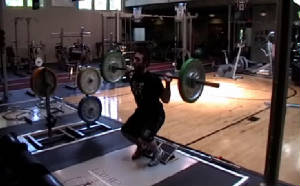
- Close Stance Front Squats-Front Squats are probably the
king of the “quad recruitment” squat. Because of the bar being in the front and the upright position you have
to keep throughout the movement, these are true quad blasters. They work exceptionally well for developing the teardrop region
of the quad. If you suffer from “turnip legs” you should definitely incorporate front squats in your workout.
For the Close Stance Front Squat, the feet should be pointing ahead and slightly a little narrower than your hips. There is
no need to go ATG (ass to the ground) with these. You do want to hit parallel or slightly below. You also do not want to lock
out at the top of the movement. Once you get three to four inches from the top begin to descend for another rep.
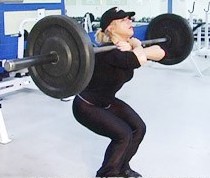
- Hack Machine or Smith Machine
Sissy Squats-They may be called sissy squats but they will make a tough individual out of you quick. If you are not doing
some form of sissy squats for quads, then you’re shortchanging your legs. Sissy squats are great for bringing out that
outer quad sweep of the legs. If you want to do sissy squats or are currently doing them, be sure to do either the hack squat
or smith machine variety. These are two of the lesser known versions of the sissy squat but probably two of the most effective
versions.
Hack Machine Sissy Squats- Place
your shoulders into the pads like you would a normal hack squat. Keep your feet underneath you and bow your body out. With
your shoulders still on the pads push your body and butt as far away from the pad as possible. Slowly lower yourself down
into bottom position. Once as far down as you can go slowly reverse directions until your back in starting position.
Smith Machine Sissy Squats- Line up in a Smith Machine with the bar against your chest. Place your toes about
three to five inches behind you so you are leaning up against the bar. You can either hold the bar against your body or hold
the bar in front squat position. Go up on your tippy toes and unhook the bar from the machine. Because the Smith Machine travels
in a straight path, with your toes behind you will go down in a sissy squat angle. Once you are down to where you feel a good
stretch in the quads. Slowly reverse direction until you at start position.
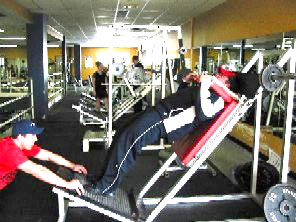
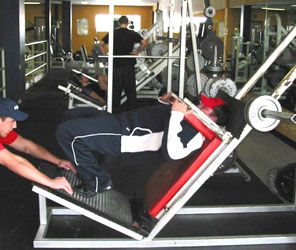
- Lumber Jack Squats- I’m sure not a lot of people
have heard of or use this exercise. The Lumber Jack squat is one of the best ways to teach proper squat form and develop quad
power and size. Another plus is there is much less spinal compression from this exercise.
Execution-Use a t-bar row or place one end of a Olympic bar in a corner. Load the opposite side up with weight,
grab the bar with both hands and hold at chest level. Keep feet about hip distance apart. Then begin to perform squats.
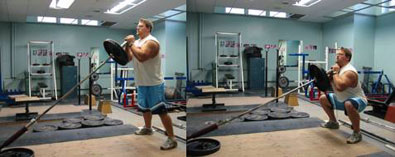
- Feet Together Leg Press- The traditional
leg press is great for leg mass in general. It is also a great alternative to those who have issues with squatting. To make
the leg press more quad friendly, just change your foot positioning. To hit your quads more on the leg press keep your feet
lower on the foot pad and closer together. By making these simple changes you really feel your quads work on this one!
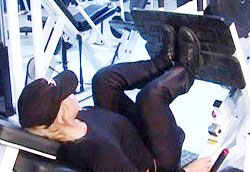
- Short Stride Lunges- Again this is taking a regular exercise and adding
just a slight tweak. Set up like you would do for a normal lunge. Now instead of taking a normal lunge stride, place your
foot just one footstep forward and squat down like a lunge. Stand back up and repeat alternating between feet.
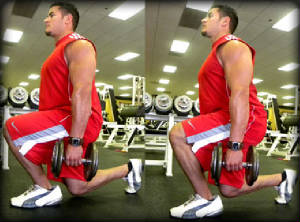
Developing a great set
of quads may not be as complicated as you would think. It may simply boil down to examining what your doing, how you place
your feet, or the elevation you are using when you train. Improving your quads may even be a matter of finding the right exercises
for your goals. If developing a better set of quads is your goal try a couple of these changes. If you’re looking for
some variety in your quad training, why not try a couple of these quad dominate exercises? It all comes down to what style
you are going to use for this fight.
|

